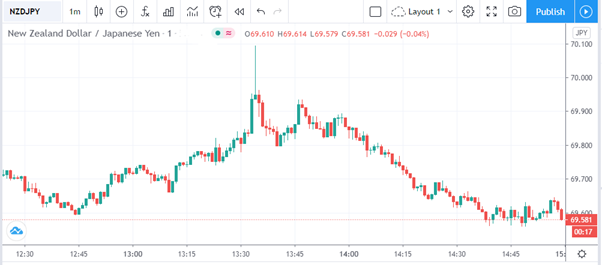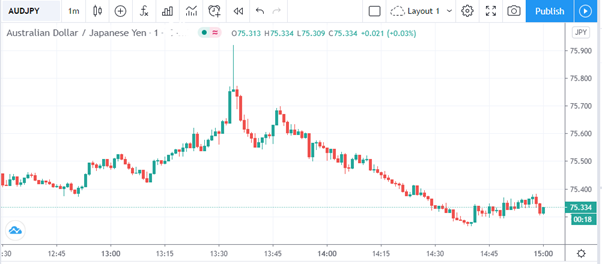U.S. and Eurozone data tends to have a huge impact on many forex pairs. Keeping up with all the data as it comes in is no easy feat, which is what makes trading NZDJPY an attractive option – the pair is almost immune to most E.U. and U.S. data. Trading this pair can streamline the amount of data you have to analyze and make your trading that much simpler.
To trade NZDJPY:
- Formulate a trading plan that includes a strategy for getting into and out of trades.
- Select a broker and trading platform.
- Determine the best time to trade NZDJPY.
- Choose to buy or sell based on your market analysis.
- Open a trade and add risk management orders to minimize risk.
- Monitor your position and close the trade.
The NZDJPY pair represents a combination of a risk-on currency (NZD) and a risk-off, safe-haven currency (JPY). Although this combination can be volatile, the pair still has several benefits that make for advantageous trading. With that in mind, let’s have a closer look at NZDJPY.
Table of Contents
Currency Chart and Pair Profile
The economies behind NZDJPY
New Zealand ranks 52nd in regards to GDP. The New Zealand dollar is called a commodity currency the country’s economy relies significantly on commodity exports, especially those of wool, meat, and milk. Tourism is also a big contributor to New Zealand’s economy.
Japan is the world’s third-largest economy meaning it comes 3rd in GDP rankings. Although the Japanese yen is not a commodity currency, Japan’s economy relies heavily on commodities and it also imports a lot of food and agricultural products. Since many of these imports originate from New Zealand, NZDJPY is the most-traded of all the pairs involving NZD with regards to volume.
New Zealand’s monetary policy is managed by the country’s central bank, the Reserve Bank of New Zealand (RBNZ). On the other hand, Japan’s central bank, the Bank of Japan (BOJ), oversees the issuing of the yen and the management of the country’s monetary policy.
What influences the movement of NZDJPY?
NZDJPY is often influenced by Japan’s and New Zealand’s political and economic policies as well as factors such as inflation, unemployment rates, and GDP growth. Since New Zealand’s economy relies heavily on commodity exports, rising commodity prices and a surge in exports can affect the NZD, and in turn, the NZDJPY pair.
Japan has low inflation rates and an aging population, therefore, the JPY can be affected seriously by factors such as interest changes, inflation data, balance of trade data, and unemployment rates. In cases of the Japanese economy showing weakness, the Bank of Japan may intervene with monetary policy and this can affect the NZDJPY pair.
NZDJPY is responsive to both domestic economic news and that of key trading partners such as China. It’s also sensitive to swings in market sentiment. This makes it one of the most volatile pairs in the forex market.
It’s also important to remember that since NZDJPY is not usually affected by Eurozone and U.S. events, events that negatively impact these regions will probably strengthen both the JPY and NZD and influence NZDJPY price movements.
Is NZDJPY an exotic pair?
NZDJPY is a minor pair. A currency pair is considered exotic if it consists of one of the major currencies and a developing or emerging country’s currency. Since NZDJPY comprises two major currencies, it’s not an exotic currency pair.
Pros of trading NZDJPY
Trading the NZDJPY pair has numerous benefits you can capitalize on to increase your chances of succeeding in the forex market.
- The volatility of the NZDJPY pair can mean more trading risk, but the bigger price movements also present the potential to make larger gains.
- Although many traders typically avoid the Asian session due to the low liquidity associated with it, both the NZD and JPY can make substantial moves during this session.
- Crosses such as the NZDJPY tend to form longer and stronger trends compared to the major pairs. As a result, analyzing the NZDJPY will probably be simpler relative to a pair such as EUR/USD.
- The lower yield of the Japanese yen makes the currency an attractive choice for carry trading.
Cons of trading NZDJPY
You also have to keep in mind the cons of trading NZDJPY. Perhaps the biggest drawback to trading NZDJPY is that since minors aren’t as liquid as majors, your broker may charge you wider spreads. Additionally, even though both the NZD and JPY can make significant moves throughout the Asian session, the lower liquidity associated with the session can make trading slow, especially for day traders.
The Best Time to Trade NZDJPY
NZDJPY is traded most actively during the Asian trading session which is when both the Japanese and New Zealand markets are open. This session runs from 10 pm to 6 am GMT. The pair’s trading volume tends to be at its peak during this period and spreads are typically lower.
Nonetheless, the yen can be active in other sessions when economic data relevant to the currency is released. This means that you can capitalize on the data that comes in during other sessions to set up your NZDJPY trades.
Best Trading Strategies for NZDJPY
The top strategies for NZDJPY trading include:
Swing trading
NZDJPY tends to have strong ranges that can run longer than a whole year. You can use them to set the resistance and support levels, then buy at support and sell at resistance.
Historically, NZDJPY has had a range of movements that typically run between a certain number of pips. Knowing this range can make forecasting future price movements easier.
Note: Japanese industrial companies usually set their orders at round figures such as 90.50 or 101.00. These figures can potentially serve as short-term levels of support and resistance, so you should keep an eye out for them.
Trend trading
Similar to the strong ranges, NZDJPY also tends to have strong trends. You can use the upward or downward movements to trade the NZDJPY pair. You can enter into a long position when NZDJPY is moving upward and enter into a short position when the pair is in a downtrend.
Keep in mind that Japanese asset managers tend to make similar investment decisions. This leads to highly correlated positions which can lead to the development of trends.
Scalping
In forex trading, scalping involves buying or selling a currency pair then holding it for a short period while attempting to capture small gains such as 5 to 20 pips per trade. The idea with scalping is to make many small gains instead of waiting for one big gain. Sometimes traders increase their lot size to potentially magnify their gains.
NZDJPY tends to make very fast and strong movements that can even persist longer than some typical scalping time frames. As such, it makes a good scalping pair option even though its spreads are sometimes not the tightest.
Since scalping is characterized by entering and exiting trades within short time periods, you need to have a robust entry and exiting strategy. For example, you can choose to trade a long-term trend, exiting your position when movement decreases momentum and looking for another opportunity.
New Zealand and Australia have other connections besides their proximity. Their economies are closely tied. Both economies rely on commodity exports and there is also a lot of trade between the two countries. As such, NZDJPY shares a high correlation with AUD/JPY.
Other yen crosses such as EUR/JPY and GBP/JPY can also affect NZDJPY. If any of these crosses are about to break a key technical level, they could unlock a lot of JPY buying or selling that can affect NZDJPY.
Correlation of NZDJPY with other indices, instruments or commodities
The commodity-based NZD tends to fluctuate due to the Global Dairy Trade Index and the ANZ Commodity Price Index. Both indices can cause the NZDJPY pair to move significantly.
In terms of the Japanese economy, you should note that Japan has no major crude oil reserves. This means that the country relies significantly on imports and so movements in oil prices tend to impact the NZDJPY. Other commodities such as aluminum, steel, and coal can also influence the movement of NZDJPY price movements due to the size of Japan’s manufacturing sector.
Related Questions
Here are some questions linked to trading NZDJPY
How do you trade currency volatility?
The NZDJPY pair is quite volatile and can make big market moves. Knowing how to trade currency volatility is important because the pair is more prone to slippage compared to other currency pairs with low volatility. These are some tips for trading a volatile pair such as NZDJPY:
- Analyze and trade the pair using charts and indicators
- Trade the pair around news and events
- Stick to your trading strategy and set stop losses to minimize risk
- Keep a trading journal to have a better understanding of how volatile trades work
Why is yen considered a safe currency?
Many investors perceive the Japanese yen as a safe currency because during periods of economic uncertainty, the currency tends to strengthen. Even negative interest rates don’t usually discourage currency capital inflows because Japan’s debt structuring means that the yen remains stable during uncertain times.


